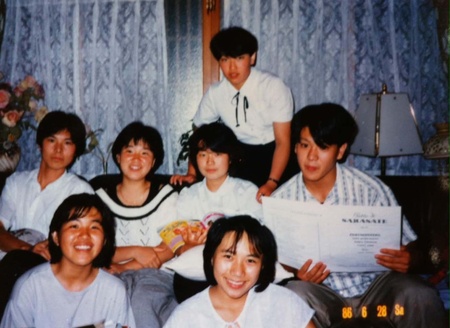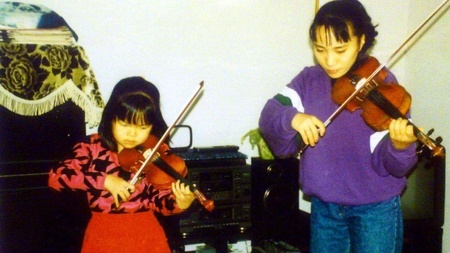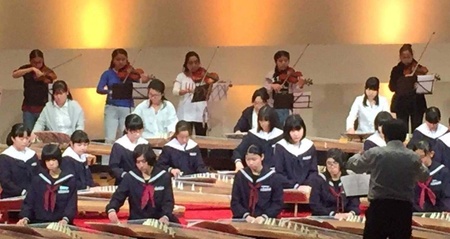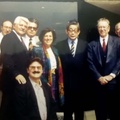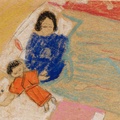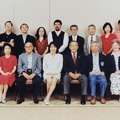Rie Watanabe was barely five years old when she met violinist Yuriko Kuronuma, who was already an established violinist worldwide and alternated as a soloist in several symphonies around the world. At that time, Kuronuma was on tour in his country of birth and the little girl was in charge of giving him a bouquet of flowers during the concert he gave in the city of Yamaguchi.
Rie had the opportunity to perform a piece of music before Kuronuma who was pleasantly surprised by the girl's enormous potential and ability to play the violin. In recognition of her performance, Kuronuma gave her an indigenous doll made from corn husks that he had brought from Mexico. This contact with Kuronuma and with such a distant country would mark Rie's life definitively.
Kuronuma had lived in Mexico since 1962 when she married a Mexican student she had met in Prague where they both perfected their knowledge: she in music, he in anthropology. In 1980, already with a long career as a violinist, Kuronuma opened an academy in the Coyoacán neighborhood in Mexico City where he taught children how to play the violin.
Rie Watanabe, when she was 17 years old, traveled to Mexico in 1986. Through the American Field Service (AFS) student exchange program, she managed to stay for a year with the aim of learning the Spanish language. and attend the Kuronuma academy to continue improving violin performance under the guidance of the famous violinist. The young woman lived with a Mexican family and attended a preparatory school where she began to learn Spanish, learning seasoned with a large number of “bad words.”
Rie would temporarily return to her country to finish her high school education and later moved to Mexico City to work as an assistant to Professor Kuronuma at her academy in exchange for the consecrated violinist continuing to prepare her in the technique and interpretation of the violin as soloist.
In 1989, as part of his musical training, Rie moved to New York where he entered the world-famous Juilliard School and later graduated in arts from Western Illinois University. In these important music teaching centers, he managed to acquire a highly developed technique in playing the violin, a fact that assured him a promising future in this field. However, finding herself in an environment that rewarded individualism and competition as the only way to interpret music, the young woman felt a void in her heart that began to cause deep inner loneliness and stress that affected her health.
Faced with this situation, the young woman decided to look for an environment in her country that was more conducive to her development as a violinist but that at the same time would allow her to share what she had learned over so many years of study. He thus entered the Naruto University of Education in Tokushima to specialize in the area of ethnomusicology and violin teaching. The topic of the thesis with which he graduated was related to Mexico as it addressed the work of the Zacatecan musician Manuel M. Ponce. In the following years, Rie dedicated herself with great care, as a music pedagogue, to teaching violin to children and to teaching classes at Shikoku University in Tokushima.
Rie felt satisfied as a teacher and with her work alongside children; However, he considered that his work would have greater significance and usefulness in Mexico. In 2000 he returned to that country again and in the following years he began to transmit what he had learned in the United States and Japan to Mexican children at the Kuronuma Academy and to young people at the University of Sciences and Arts of Chiapas (UNICACH) in the city of Tuxtla Gutierrez. They were years in which he did not rest any day of the week because he also offered concerts in various venues such as the Nezahualcóyotl where he had debuted as a soloist years before.
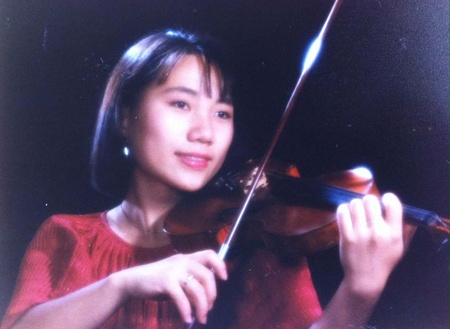
The recognition and capacity that she was acquiring as a violinist and teacher opened the doors for her to be included in some repertoires of ensemble groups and symphonies in Toronto, Canada. Faced with this new perspective of his career as a violinist, he had to move to that country, although every two months he returned to Chiapas to continue his teachings at UNICACH. The rhythm and commitments that he acquired as a professional violinist questioned him about how to properly organize and channel his personal life. Once again he was presented with the dilemma of getting involved in a professional career where competition was the way to stand out and where what the musician learns is jealously guarded as if it were a treasure that should not be shown to anyone else as the only way to stand out. This situation took a toll on his health, causing emotional blindness that temporarily prevented him from reading musical notes. To face this situation, Rie made a momentous decision.
The violinist considered that music must be an instrument for searching for inner truth. This strong conviction led her to permanently leave her career as a soloist in Canada. He decided to settle permanently in the state of Chiapas and dedicate himself to teaching the violin to indigenous children and promoting community projects that promoted the traditional music of the towns. As part of this path, in 2007 he joined a rock group of Tsotsile musicians, Sak Tzevul, of which he would be a part for some years.
Sak Tzevul, a name that means lightning in that Mayan language, allowed him not only to explore new ways of playing the violin but also allowed him to get to know the native peoples of Chiapas in greater depth. The group made various tours in Mexico and other countries such as the United States, where they debuted in 2010 at the National Museum of Mexican Art in Chicago, and later in Japan in the cities of Tokyo and Osaka.
Between 2014 and 2020, Rie has been collaborating with two very important community projects: one with the Mixteca orchestra Pasatono , teaching various violin workshops to children in towns such as Tezoatlán de Segura y Luna, Llano Grande la Banda, among others. With this orchestra led by maestro Rubén Luengas he participated in the tours he made to the cities of New York and Washington.
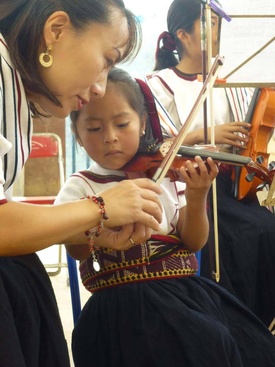
The other project, in collaboration with the San Agustín Arts Center (CaSa) in Etla, called “Automodel for the music of the oral tradition in Oaxaca” allows children and young people from different communities originating from Oaxaca, such as Mixes and Mixtecas among others, they become musical leaders so that they take charge of the dissemination and teaching of their own music in their towns.
In 2019, together with Meizan Yamagami, a shakuhachi (traditional Japanese flute) teacher, he organized a tour to Japan with six students representing various communities in Oaxaca with the purpose of showing the musical heritage of this State. The exchange with Japanese children in these concerts allowed the students of the communities to better prepare themselves and learn musical forms from both cultures.
Throughout all these years, Rie Watanabe was gradually discovering the life and culture of the indigenous peoples of the southeastern region of Mexico. He managed to observe the threads that shape the stories of the communities that constitute an enormous fabric of peoples, of denied, unseen civilizations that the Mexican archaeologist Guillermo Bonfil called Deep Mexico. As a Japanese immigrant she has managed to value that Mexico of which she is now a part through her music and her violin.
© 2020 Sergio Hernández Galindo


